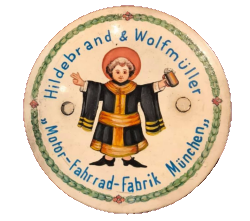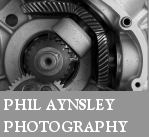


The Hildebrand brothers formed a partnership with Alois Wolfmuller, producing their first machines in 1894 with a water-cooled twin cylinder fourstroke engine of 1488cc. Drive was by connecting rods to the rear wheel. Built from 1894 to 1897, these were the world's first production motorcycles.
They patented their design on January 20 1894, using the German word "motorcycle" for the first time. The Hildebrand & Wolfmüller patent of 20 January 1894, No. 78553 describes a 1,489 cc (90.9 cu in) two-cylinder, four-stroke engine,
In France they were built by Duncan & Suberbie who in November of 1894 obtained the rights to manufacture the Motor-Rad.
Das allererste Serienmotorrad
Die Konstrukteure Sind Alois Wolfmüller, Flugpionier und Hans Geisenhof, Mechaniker. Im Verleger. Rad- sportier und Ingenieur Heinrich Hildebrand, der nach Versuchen mit einem dampfgetriebenen Zweirad ebenso auf den Benzinmotor setzte. fanden sie einen finanzstarken Mitstreiter. So entstand 1892 nach Vorversuchen ein Zweizylinder-Aggregat. Fahrradrahmen zeigten sich diesem Motor nicht gewachsen — mit eigenem Fahrgestell wurde das Fahrzeug 1894 als "Zweirad mit Petroleum- Oder Benzinmotorantrieb« patentiert.
Zeitgleich kreierten die Konstrukteure erstmalig den Begriff ,.Motor-Rad". Optimistisch erfolgte 1894 die Gründung einer Fabrik zur Serienfertigung.
Der wassergekühlte Motor (das hintere Schutzblech diente als Reservoir der Verdampfungskühlung) trieb gleich einer Dampfmaschine das Hinterrad direkt an. Ein Oberflächenvergaser sorgte für Gemisch, die Aus- lasssteuerung erfolgte vom Hinterrad aus, der Einlass über ein Flatter-ventil. Verstellbare Gummibänder unterstützten den Rundlauf des Motors. Auch die Luftbereifung des Motorrads feierte hier Premiere. Nach anfänglichen Verkaufserfolgen mehrten sich Klagen, vor allem zur damals schon fragwürdigen Glührohrzündung. 1895 meldete die Firma nach etlichen hundert verkauften Exemplaren Konkurs an.
The very first production motorcycle
The designers are Alois Wolfmüller, aviation pioneer, and Hans Geisenhof, mechanic. They partnered with publisher, cyclist and engineer Heinrich Hildebrand, who after tests with a steam-powered two-wheeler, also developed a petrol engine. Hildebrand financed the development. Thus, in 1892 after preliminary tests, a two-cylinder unit was decided upon. Bicycle frames were unsuited to this engine so with its own chassis, the vehicle was patented in 1894 as a "two-wheeler with petroleum or gasoline engine drive".
At the same time, the designers for the first time created the term "Motor-Rad" (Motor Bicycle). Perhaps somewhat optimistic, in 1894 they built a factory for mass production.
The water-cooled engine powered the rear wheel directly, in the manner of a steam engine, and the rear mudguard served as a reservoir for evaporative cooling. A surface carburettor provided the mixture, the exhaust control was from the rear wheel, with the inlet tract via a flutter valve. Adjustable rubber bands supported the engine.
The pneumatic tyres were another first.
After initial sales success the number of complaints increased, especially about the then questionable hot-tube ignition system. In 1895, the company filed for bankruptcy, having sold several hundred machines.
Specification
Examples of the "Motorrad" exist in the Deutsches Zweirad Museum, Germany, the Science Museum in London, the Henry Ford Museum in Detroit, and the Tekniska museet Stockholm.
Max Turkheimer of Italy began importing Hildebrand & Wolfmuller motorcycles in 1894.
In 1898 Hildebrand established a flying machine factory in Berlin. He later established Auto-Motoren-Industrie GmbH in Berlin-Schöneberg building bicycle auxiliary engines - see AMI.
Sources: Zweirad Museum, deutsche-biographie.de.
A motor cycle, which arrived in Brisbane nearly two months ago, and which, when exhibited in the window of the Austral Cycle Agency, Queen-street, created no end of excitement, has at last been given a trial on the Brisbane roads, and, no doubt, a slight description of this unique machine will be interesting.
The motor bicycle was specially imported from the Continent by Mr. J. C. Brunnich, of Mackay. When it arrived in Brisbane last month a trial of its powers could not be obtained owing to the fact that the benzol required to supply the motive power was not obtainable in Brisbane. However, Mr. Brunnich, when in Sydney a few weeks ago, obtained a small quantify of benzol, by which the present trial was enabled to take place. The motor cycle is the first of its kind ever imported into Australasia, and is a machine of the ordinary safety bicycle type, fitted with a motor driven by benzol.
The tank holding the benzol is capable of carrying about two gallons of the liquid, which is sufficient to drive the motor a distance of 200 miles. From the tank a small pipe leads to a lamp fitted nearly underneath the front part of the machine, in which are placed two nickel tubes kept at an incandescent heat by vapourised benzol. The exploding mixture, when discharged in one cylinder is admitted into the other, the explosion being made through compression of the mixture in the hollow nickel tubes referred to above, which are fitted in the base of the cylinders.
The valve gearing for regulating the admission of the mixture to the cylinders is worked by an eccentric. The cylinders are single-acting, of 3¼in. diameter anti 5½in. stroke, and when working at full capacity develop 3 horse-power. The exhaust gases from the cylinders are carried away by an ingenious method attached below them, thereby doing away with all smell, and conducing to the comfort of the rider.
Over the back wheel - the place for the usual mudguard - is fitted a water tank, or cooler, from which the water circulates round the cylinders, keeping them cool and preventing any possibility of overheating. This reservoir of water is necessary owing to the high speed at which the engines run. The water stored here has to he changed after running 100 miles. The driving or rear wheel is built of two steel plates on the disc principle, in place of spokes, thus being absolutely necessary to support the weight of the motor and rider. The driving wheel is 24in. and the steering wheel 30in. in diameter, the pistons working direct on to the driving wheel.
Benzol, as before stated, is the agent supplying the motive power - not benzine. Benzol and benzine are entirely different, and here it may be interesting to compare both products. Benzol is 80 specific gravity C6H6. 80c being its boiling point. Benzol is a by-product of coal tar. The benzine of commercial use is a hydrocarbon, of the formula CnH2n plus 2 and is a cheap by-product of kerosene, and similar in composition to gasoline. Benzine is quite unsuitable for motor use, and is also more volatile than benzol.
This benzol motor cycle has been ridden - or driven rather - by the owner, Mr. Brunnich, and two local cyclists (Messrs. H. K. Eaton and J. Adams), who have the honour of being the first to try the coming form of propulsion. The gentlemen named above have come to the conclusion that the motor cycle is a success, and that it will do all that is claimed for it. When ridden round the streets of the city, one of the riders mentioned, on a quiet level piece of running, estimated that the motor must have been travelling at the rate of thirty miles an hour.
Of course at such a high speed the vibration on the hands is very great - for the machine is steered like the ordinary safety bicycle - but when running at a moderate speed the vibration is no greater than that from the pedal-driven safety. In the trials round the city the horses met with on the roads did not take more notice of the novelty than that which an ordinary bicycle and rider claims. Only a slight noise is made by the motor by the discharge of the exhaust gases from the cylinders.
An ingenious contrivance attached to the handle-bar regulates the speed of the machine, which is also fitted with a powerful brake, and specially prepared pneumatic wheels, the tires being nearly ½ in. thick. The machine is dependent wholly upon its motive power for propulsion, and is not fitted with pedal gearing, which would be useless, owing to the weight of the machine - some 200lb. It is probable that a public exhibition of the machine's powers will be given at an early date in Brisbane. The motor cycle was made by Messrs. Hildebrand and Wolfmuller, of Munich.
The Brisbane Courier, Sat 8 Feb 1896. Trove NLA
Sourced by Murray Barnard.
N.B. Leon Mitchel suggests that the machine imported to Australia was an Ariel. See Austral.
Among the next of the pioneer motor bicycles to attract attention was another German make, shown at Fig. 3. This was constructed by Wolfmueller & Geisenhof, of Munich, Germany. In ordinary appearance it resembled the conventional bicycle design intended for the use of women though the machine had exaggerated dimensions. The saddle was placed low so that the rider could rest his feet on the ground if he desired. The power plant was a peculiar form which was said to develop two horse-power, and which was capable of propelling the 110-pound machine at speeds ranging from three to twenty-four miles per hour. The motor was of the two-cylinder horizontal form having the cylinder heads at the front of the machine while the open ends of the cylinders pointed to the rear. The connecting rods extended to cranks attached to the rear wheel axle, and the drive was direct from the motor cylinders to the traction member as in locomotive practice. Ball-bearings were used at the ends of the connecting rod as well as supporting bearings for the rear wheels.
The fuel gas was obtained from a vaporizer of the surface type and the compressed charge was ignited by hot tubes. The cylinders were water-cooled and were surrounded with water jackets, and a supply of water for cooling the engine was carried in a peculiarly shaped tank forming part of the mud-guard over the traction member. The front wheel was used for steering and was mounted in forks in much the same manner as in the machines of to-day. A hand-lever actuated-spoon brake served to retard the speed of the vehicle when desired by frictional contact with the front tire. Both wheels were provided with pneumatic tires. The engine cylinders were 3 9/16 inches in diameter with a stroke of 4 5/8 inches. The driving wheel was 22 inches in diameter while the front wheel was 26 inches in diameter. It is claimed that the fuel supply was sufficient for a run of 12 hours.
Motorcycles Sidecars and Cyclecars, 1914, by Victor Page. Page 25.
Tue Sep 28 2010
parker52<at>comcast.net
for sale hilderbrand and wolfmuller
Hilerbrand and Wolfmuller orginal
Am offering orginal Hilderbrand and Wolfmuller for sale. Make offer.
USA
If you have a information about these pioneer machines, please contact us